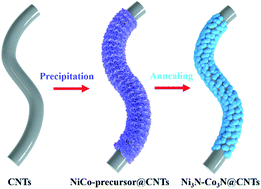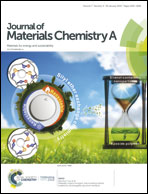Phase boundary-enhanced Ni3N–Co3N@CNT composite materials for lithium-ion batteries†
Abstract
Metal nitride materials are considered as promising candidates for next-generation lithium-ion secondary battery anode materials owing to their high electrical conductivity and attractive theoretical capacity. In this paper, we reported a synthesis method to grow ultrafine Ni3N–Co3N nanoparticles on carbon nanotubes (Ni3N–Co3N@CNTs) via a simple hydrothermal reaction and post-ammonization treatment. By virtue of such a unique structure and component, especially the abundant phase boundaries between Ni3N and Co3N, when used as anodes for lithium-ion batteries (LIBs), the resultant composites delivered reversible discharge capacity of 553.26 mA h g−1 even after 600 cycles at a current density of 0.4 A g−1. This reversible capacity was remarkably higher than the theoretical capacities of both Ni3N (424.3 mA h g−1) and Co3N (421.0 mA h g−1). We believe that this study will provide a new idea to design high-performance anode materials for LIBs via constructing abundant phase boundaries between different components in composites.



 Please wait while we load your content...
Please wait while we load your content...